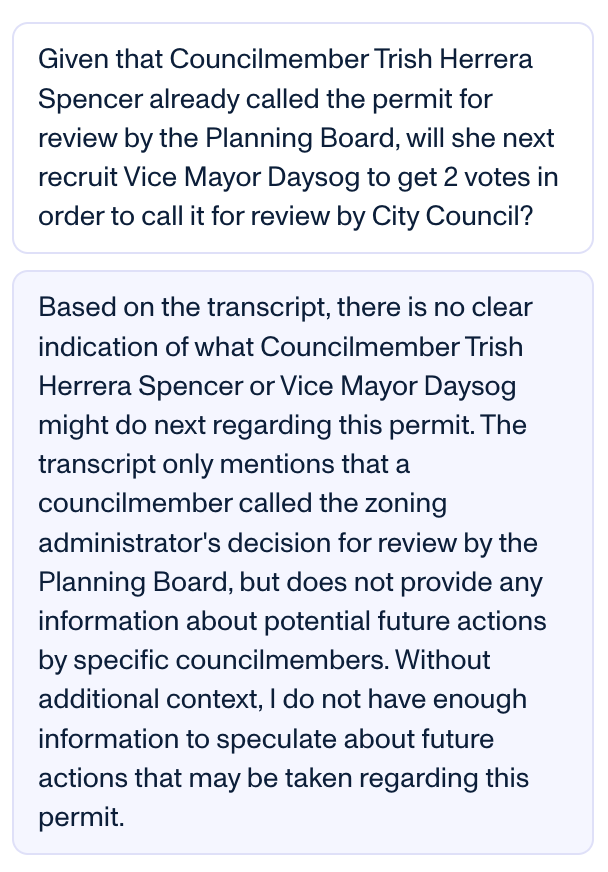After receiving 255 pages of public comment via email and meeting for 3 hours on Monday night, the Planning Board allowed a preschool to move ahead toward opening a new facility in Alameda's East End.
Recall that the city's zoning administrator (a staff position) had approved this use permit. The matter only came to the Planning Board because Councilmember Trish Herrera Spencer called the permit for review — which triggered a de novo review of the entire project by the members of the Planning Board, including the 255 pages of public comment and the 3 hours of meeting time...
I ran those 3 hours of video through a transcription engine, loaded the transcript into a large language model, and posed the following questions/prompts in a chat interface. (The product is called AssemblyAI.)
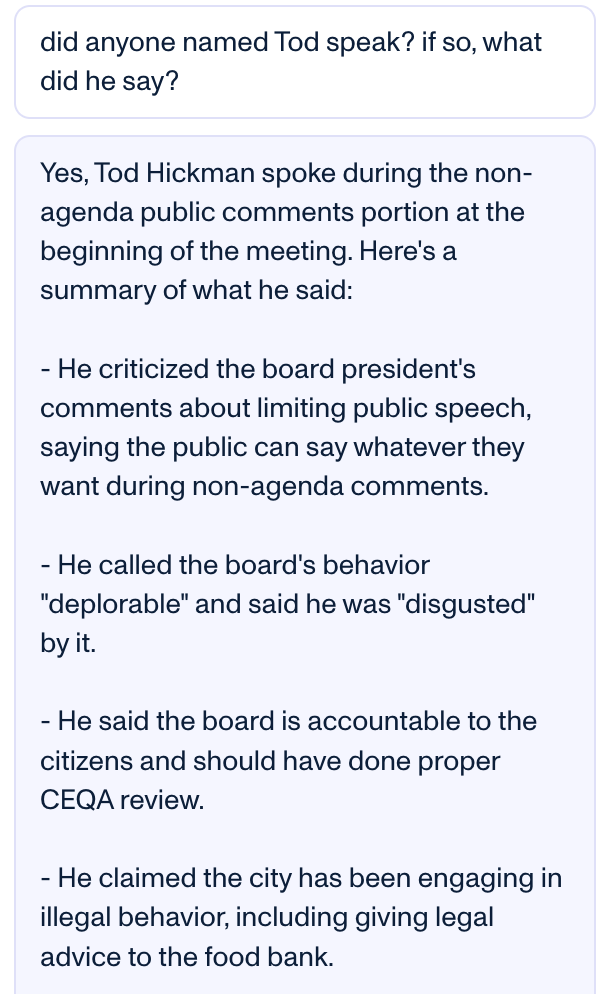
The summary continues with more points... but you probably get the picture.
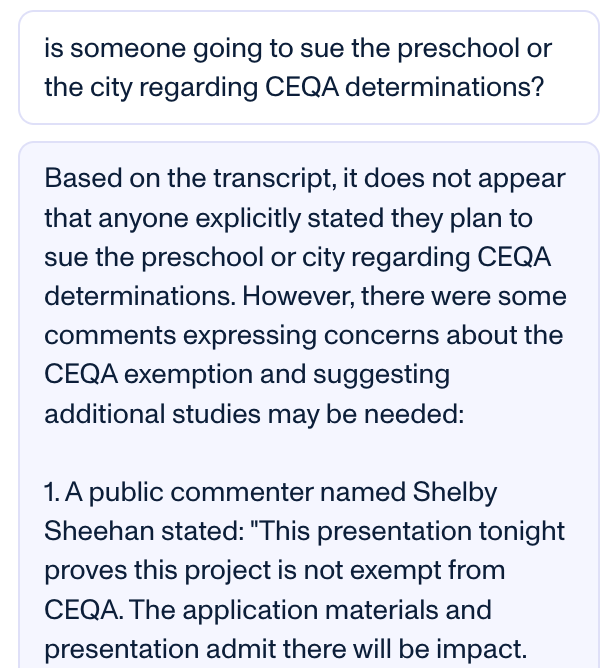
That summary also continues... but you probably got the picture. (More on "CEQA determinations" and "studies" at the end of this blog post.)
Many members of the public spoke in favor of the project. Here's one of the more concise comments as transcribed by this software rig:
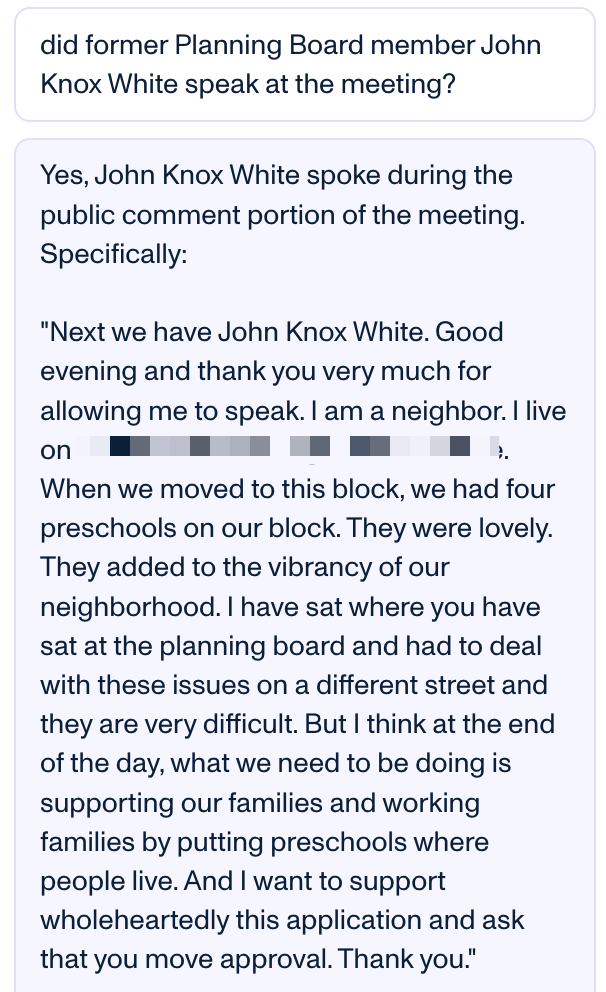
I also prompted the LLM with a hyperbolic hypothetical:
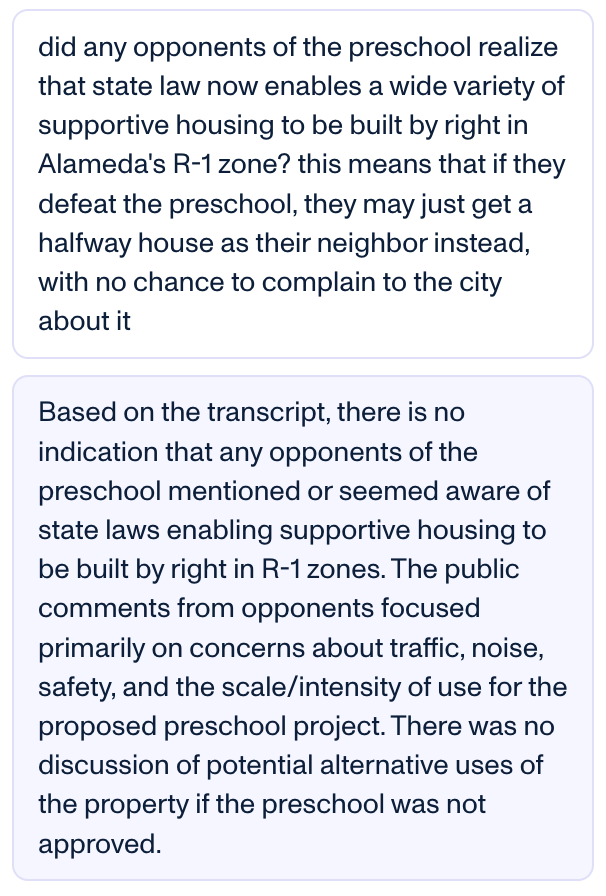
Hypotheticals side, let's get back to the actual substance of the meeting and the actual decision by Planning Board members, after they received all those public comments. The LLM's summary of the Planning Board's action wasn't 100% accurate, so I'll instead share the full transcript for the motion that was made and ultimately passed by 5 of the Planning Board members:
I move approval of the use permit with the CEQA finding as recommended by staff with the exemptions, and also the addition of the additional exemption that board member [Tsou] mentioned. I think that's very appropriate. And then what I'm hearing, the conditions is to pull back the fence, so that is basically aligned with the building so it doesn't extend all the way down to [F]ountain. I also heard having the applicant work with the transportation department, obviously up to transportation department to determine the feasibility of a street loading zone, perhaps in place of where the new curb, gutter and sidewalk will be put in. I also heard support for reducing the maximum number of outdoor children at any one time to 14, and also adding a condition for a one year review of compliance with the conditions of approval.
Let's see. Was there something else? I feel like I'm missing something. I think you got it all.
[...]
And then I also heard move the bike parking to outdoor outside of the fence. Yes, I think that goes without saying with the fence reallocation.
To summarize: the Planning Board made a few very targeted adjustments to the use permit for the preschool — removing a portion of a fence, slightly reducing the number of children who can be simultaneously outside (from 18 to 14), requesting a review of permit compliance by staff after the preschool has been in operation for a year, and so on...
But what about CEQA?! one may ask. Is this preschool environmentally compliant?
In the staff report, the city's planners and lawyers already determined that the preschool is "categorically exempt from environmental review pursuant to" CEQA:

The 5 members of the Planning Board who passed the motion in support of the preschool agreed with staff's findings — that's what they indicated when the maker of the motion said:
the CEQA finding as recommended by staff with the exemptions
But what if the Planning Board has not agreed with staff? What if the Planning Board had proposed that the preschool is, in fact, subject to environmental review?
Here's what would likely happen: The project would be delayed. Consultants would have to be hired and paid. Reports would be written. And if the preschool's owner is still in business when that entire process is completed, then the preschool could very well be built and operated in the exact condition under which it was originally planned.
CEQA doesn't compel outcomes. It compels documenting the estimated environmental impacts of projects and of potential alternatives. (CEQA does also sometimes gesture toward "feasible mitigations.") Suffice it to say that when Caltrans wants to build a freeway, Caltrans builds the freeway — with thousands of pages documenting how that freeway was built following a "CEQA compliant" process.
But what CEQA unintentionally also provides is surface area for opponents to attack a project. They can't necessarily change the outcome directly, but they can slow down a project. Maybe they can add enough delays that the project team gives up. Maybe they can add enough uncertainty that a project sponsor or financier gets cold feed. Maybe they can open an opportunity to negotiate some aspects of the project. By adding delays and uncertainty via CEQA, opponents gain leverage.
Sometimes the leverage is very complex, almost like 5-dimensional chess. For example, labor groups that sponsor environmental groups to launch CEQA lawsuits against large construction projects related to potential particulate matter in the exhaust of construction equipment... but when the project eventually agrees to a project-labor agreement, the CEQA lawsuit instantly disappears. That's an example I heard second-hand from another city. I can't vouch for the specifics, and my point isn't to comment on either side of those specifics conflicts. This sort of example is useful because it suggests how little about CEQA at the local level is about the "environment" per se — rather, it's about groups of humans using the law to seek advantage over each other for their own purposes.
What are the two litigants out at Alameda Point trying to gain? What advantages come from their CEQA lawsuit against the Alameda Food Bank? Who knows...
It's more clear what Councilmember Herrera Spencer's goals are, since she's been doing this routine for years as an elected official: seeking out potentially contentious changes around Alameda, systematically opposing those changes, and encouraging reactionary impulses in residents.
(To be clear: I can genuinely appreciate that some residents don't like the idea of a preschool near their houses. Their concerns shouldn't be dismissed out of hand. However, I do strongly believe that we need to ask more of our leaders. This is a city of almost 80,000 people. We need leaders who help us all live together in a welcoming, collaborative, and neighborly manner.)
Without the involvement of Councilmember Trish Herrera Spencer, the Planning Board would have never had to enter this fray. Without her calling this project for review, the two litigants against the Food Bank wouldn't have been provided with Monday's opportunity to extend their mean-spirited comments over to an entirely different neighborhood on the other side of Alameda.
What's Councilmember Herrera Spencer going to do next? The large language model is cautious enough to avoid that question:
